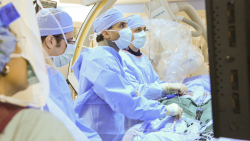Home > New Research from Dr. Mehdi Razavi and Team Sheds Light on the Structural Effects of Radiofrequency Ablation on the Heart
New Research from Dr. Mehdi Razavi and Team Sheds Light on the Structural Effects of Radiofrequency Ablation on the Heart
A new study led by Dr. Mehdi Razavi, Director of Electrophysiology Clinical Research and Innovations at The Texas Heart Institute at Baylor College of Medicine, along with a multidisciplinary team that includes, Drew Bernard, Luis Hector Victor, Christine Cao, Skylar Buchan, Mathews John, Payam Safavi-Naeini, Allison Post, Deborah Vela, and K. Jane Grande-Allen. The research provides important insights into the structural effects of radiofrequency (RF) ablation on the papillary muscle–chordae tendineae junction.
Published in Pacing and Clinical Electrophysiology (PACE), the research, “Uncovering the Structural Effects of Radiofrequency Ablation on the Papillary Muscle–Chordae Tendineae Junction,” examines how RF ablation impacts tissue strength and integrity in one of the heart’s most delicate structures.
The team’s findings suggest that while RF ablation remains an effective therapy for treating ventricular arrhythmias, it can induce microscopic changes in cardiac tissue that warrant further study to optimize procedural safety and reduce potential complications. This foundational research sets the stage for future in vivo studies to explore how these changes evolve during healing and how catheter design might improve force detection during ablation.
The study underscores The Texas Heart Institute’s leadership in advancing the science of cardiac electrophysiology and developing technologies that improve patient outcomes.
Read the full publication: Uncovering the Structural Effects of Radiofrequency Ablation on the Papillary Muscle–Chordae Tendineae Junction
New Research from Dr. Mehdi Razavi and Team Sheds Light on the Structural Effects of Radiofrequency Ablation on the Heart
Share:
More Posts

The Texas Heart Institute at Baylor College of Medicine Leads First-in-Human Gene Therapy Trial to Regenerate Damaged Heart Tissue

BCM cardiologist named a 2025 Distinguished Scientist by the AHA

The Texas Heart Institute at Baylor College of Medicine Researcher Achieves FDA Breakthrough Device Designation for Injectable Defibrillation Technology




